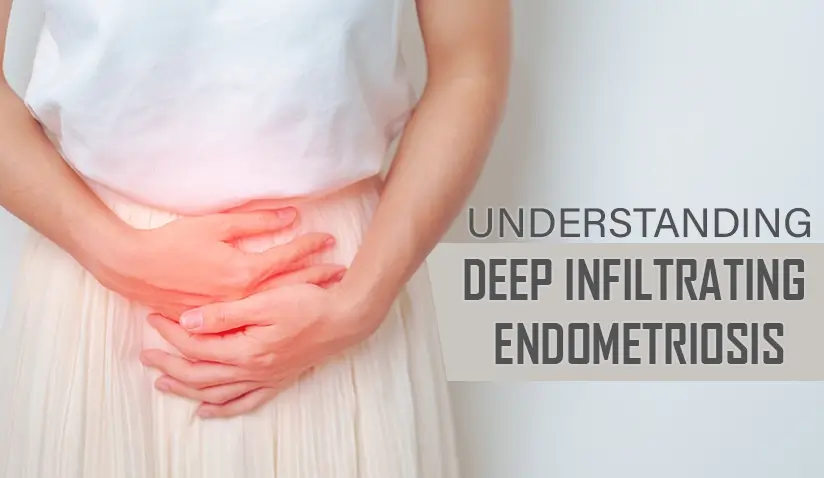Deep Infiltrating Endometriosis: Understanding and Managing a Complex Condition

What is Deep Infiltrating Endometriosis?
Deep Infiltrating Endometriosis Treatments
Deep Infiltrating Endometriosis (DIE) represents one of the most complex and challenging forms of endometriosis.
Endometriosis is a chronic gynecological condition affecting women during their reproductive years. It is marked by the growth of tissue similar to the endometrium—the lining of the uterus—outside the uterine cavity.
It responds to hormonal changes in the menstrual cycle the same as the lining of the uterus does: every month, the tissue builds up, then breaks down and sheds. However, unlike the endometrial tissue that exits the body during menstruation, the blood and tissue shed from endometrial growths have no way to leave the body. This can cause inflammation, pain, and the formation of scar tissue.
Deep Infiltrating Endometriosis (DIE)
DIE, also termed Deeply Infiltrative Endometriosis or Deep Endometriosis, is a particularly severe form of endometriosis where the endometrial-like tissue penetrates deeply (more than 5 mm) into the peritoneal cavity, affecting the pelvic organs and, in some cases, the bowel, bladder, and ureters.
This invasive and aggressive nature of DIE, which distinguishes it from other forms of endometriosis, can lead to significant anatomical distortions and severe, chronic pain that is often resistant to conventional treatment methods.
Causes
The root causes of endometriosis, including DIE, remain largely unclear, complicating efforts to develop effective treatments and preventative strategies. However, research has found several potential contributing factors.
Genetics
Evidence suggests a hereditary component to endometriosis, with people who have a first-degree relative with the condition at higher risk.
Retrograde Menstruation
One of the most widely discussed theories is retrograde menstruation, which occurs when menstrual blood, instead of exiting the body, flows in reverse via the fallopian tubes into the pelvic cavity. This backward flow can carry endometrial cells, which then implant and grow on the pelvic organs.
Immune System Dysfunction
The immune system’s failure to detect and destroy ectopic endometrial tissue may allow the misplaced endometrial cells to survive and proliferate outside the uterus, potentially contributing to the development of endometriosis.
Environmental toxins
Exposure to certain environmental chemicals has been hypothesized to affect the development and progression of endometriosis, potentially through hormonal disruption.
Menstrual characteristics
Factors such as the length, flow, and regularity of menstrual cycles may also play a role, with shorter cycle lengths and heavier flow being associated with a higher risk of endometriosis.
Lifestyle factors
Some evidence suggests that diet, body mass index (BMI), and physical activity levels may influence the risk of developing endometriosis, though these relationships are complex and require further research.
Risk factors
Recognizing the risk factors is crucial for early detection and effective management. While the exact causes of DIE are unclear, some possible risk factors include:
- Previous Surgeries: Pelvic or abdominal surgeries, such as cesarean sections or surgeries for removing ovarian cysts, can inadvertently lead to the development or exacerbation of DIE.
- Deep Ovarian Endometriosis: Also known as ovarian endometriomas or "chocolate cysts," this condition is a strong predictor of DIE. The presence of endometriomas suggests a high likelihood of endometrial tissue infiltrating deeply into pelvic structures.
- Early Menstruation: The onset of menstruation at an early age is associated with longer exposure to estrogen over a lifetime, increasing the risk of developing endometriosis, including its severe forms such as DIE.
- Long Menstrual Cycles: Longer durations of menstrual bleeding not only indicate prolonged exposure to hormonal fluctuations but also increase the likelihood of retrograde menstruation, which may contribute to the development of endometriosis.
- Low Birth Weight: A study examining over 700 women found that women with low birth weight were nearly twice as likely to develop DIE compared to those with normal birth weight, suggesting a potential link between early development and the risk of this condition.
Symptoms
In cases of deep infiltrating endometriosis, symptoms can vary widely. Some people may experience intense pain and other severe symptoms, while others may be asymptomatic, which can delay diagnosis.
Typical Endometriosis Symptoms vs. DIE-Specific Symptoms
Endometriosis, in general, is characterized by a range of symptoms stemming from the presence of endometrial-like tissue outside the uterus, which incites a chronic inflammatory response.
However, DIE has unique symptoms due to the depth and locations of the infiltrating lesions. The symptoms specific to DIE often relate to the areas of the pelvic region that are affected. Key symptoms include:
- Pelvic pain during intercourse (Dyspareunia)
- Pain during bowel movements or urination
- Heavy or irregular periods
- Chronic fatigue
- Bloating
- Infertility
Organs Affected by DIE
Deep Infiltrating Endometriosis is distinguished by its ability to penetrate deeply into the pelvic and extrapelvic organs, leading to a wide array of symptoms and complications. Organs and areas commonly affected by DIE include:
- Ovaries
- Vagina and Cervix
- Fallopian Tubes
- Bowel and Rectum
- Bladder and Ureters
- Lungs
- Umbilicus
- Abdominal Surgical Scars
- Diaphragm
- Peritoneum
The condition can profoundly impact various pelvic compartments. Compartmentalizing helps to track disease spread and impact and to tailor treatments.
Posterior Compartment
The posterior compartment includes structures such as the sacrouterine ligaments, rectouterine pouch (Pouch of Douglas), cervical sacrococcygeal fascia, rectum, and sigmoid colon. Endometriosis in this compartment can lead to significant discomfort and dysfunction, primarily impacting bowel function and sexual activity.
Symptoms include:
- Pain during intercourse (dyspareunia)
- Deep pelvic pain
- Impacted bowel function: Symptoms can include rectal bleeding, pain during bowel movements (dyschezia), and constipation.
Anterior Compartment
The anterior compartment is predominantly concerned with urinary tract endometriosis, affecting the bladder, ureters, and vesicouterine ligament. Endometriosis in this compartment can cause symptoms that closely mimic urinary tract infections but are persistent and cyclical in nature, related to the menstrual cycle.
Symptoms include:
- Blood in the urine (hematuria)
- Painful urination (dysuria)
- Urgency and frequency
Other Locations
DIE can also affect the uterosacral ligaments, broad ligaments, and ovaries, which are integral to the structural and functional integrity of the female reproductive system.
Symptoms related to DIE in these locations include:
- Deep pelvic pain
- Potential fertility issues
What Happens if DIE Is Left Untreated?
The emotional and psychological toll of living with untreated DIE can be profound, impacting personal relationships, the ability to work, and overall mental health.
Leaving DIE untreated increases the risk of chronic health issues, including the potential for developing other conditions such as fibromyalgia or chronic fatigue syndrome. Moreover, the complexity of surgical treatment increases with the progression of the disease.
Over time, the quality of life can significantly deteriorate due to chronic pain, infertility, and the potential for severe complications.
- Frozen Pelvis: This is one of the most severe complications, where extensive adhesions, scarring, and endometrial tissue growths cause the pelvic organs to stick together, severely restricting their movement.
- Spontaneous Hemoperitoneum: This condition can be life-threatening, causing bleeding that is thought to result from the rupture of blood vessels within endometrial implants or cysts.
- Impact on Fertility: DIE can significantly affect fertility by causing anatomical distortions, creating blockages that prevent the egg and sperm from meeting, or by affecting the quality of the ovarian reserve.
- Physical and Emotional Well-being: The chronic pain, fatigue, and hormonal imbalances associated with DIE can severely impact a woman's quality of life.
Diagnosis of Deep Infiltrating Endometriosis
A thorough medical history, awareness of the condition, and a combination of diagnostic techniques are critical for a correct diagnosis.
Common Tools Used for Diagnosis
- Pelvic Exam
- Ultrasound Imaging
- MRI Scan with Special Contrast Dye
- Laparoscopy
Diagnostic Approaches for Specific Conditions
Given DIE's potential to affect various organs, specific diagnostic approaches are necessary for different manifestations of the disease:
- Diagnostic tools such as cystoscopy with hydrodistension, retrograde pyelography, and urine cytology for urinary tract endometriosis.
- Concerning bowel endometriosis, tools such as colonoscopy, although not always able to detect DIE directly, can help rule out other conditions.
Treatment for Deep Infiltrating Endometriosis
Hormonal Therapy
Hormonal treatments play a vital role in managing DIE by regulating the menstrual cycle and reducing estrogen levels, which can decelerate the growth of endometrial tissue. Common hormonal therapies include:
- Birth Control Pills
- GnRH (Gonadotropin-Releasing Hormone) Agonists
- Progestins
Medications
Drug-based management can involve NSAIDs to manage pain associated with endometriosis by reducing inflammation. For DIE affecting the urinary tract, medications that alleviate bladder spasms can improve urinary symptoms and discomfort. Nerve blockers and other pain management strategies might be involved in managing chronic pain. These may include neuropathic pain medications and, in severe cases, referral to a pain management specialist.
Interventional Radiology
In selected cases, interventional radiology techniques, such as embolization, can be employed to target DIE lesions directly, offering a non-surgical option to reduce symptoms.
Role of Diet and Nutritional Interventions
Although not a standalone treatment, dietary modifications can support overall treatment goals. A diet rich in fruits, vegetables, and omega-3 fatty acids and low in red meat has been associated with reduced endometriosis symptoms.
Surgery
Minimally invasive (laparoscopic) surgery to remove or ablate (using laser energy) endometrial implants is often effective in reducing pain and improving fertility. Laser ablation, excision, or a combination of the two is less disruptive and allows for quicker recovery than open surgery.
Surgical procedures and approaches vary based on the location and severity of the lesions.
Hysterectomy
In cases where pain is debilitating, and fertility is not a concern, or in severe, widespread disease, a hysterectomy (removal of the uterus) may be considered.
Fertility and Fertility Preservation
Fertility challenges are a significant concern in deeply infiltrating endometriosis, given its impact on the reproductive organs and potential for causing infertility. However, advancements in reproductive medicine have opened up various avenues for managing fertility issues and preserving fertility in patients with DIE.
FAQs on Fertility
Can you get pregnant with deep infiltrating endometriosis?
Yes, pregnancy is possible with DIE, but it may be more challenging. The severity and location of the disease can impact fertility, with some people requiring assisted reproductive technologies like IVF.
How fertile are you after surgery for deep infiltrating endometriosis?
Fertility can improve after surgery for DIE, especially when endometrial lesions are successfully removed and pelvic anatomy is restored. Many women experience improved conception rates post-surgery, though individual outcomes can vary based on the extent of the disease and age.
The Latest Advancements in Deep Infiltrating Endometriosis Management
Advancements in the management of DIE have been significant, focusing on improving diagnostic accuracy, treatment effectiveness, and fertility outcomes.
Key advancements include:
- Minimally Invasive Surgical Techniques: The use of robotics in laparoscopy has enhanced the precision and effectiveness of surgeries for DIE, reducing recovery times and improving fertility outcomes.
- Targeted Drug Therapies: Research into targeted therapies, such as Dichloroacetate for treating endometriosis, shows promise in addressing the underlying mechanisms of the disease.
- Ongoing Research: Investigations into potential new treatments, including aromatase inhibitors and advanced ablation techniques, are underway, aiming to offer more effective and less invasive options for managing DIE.

Dr. Pedro Barri Soldevila is a Gynecological Surgeon and the Head of the Department of Obstetrics, Gynecology and Reproductive Medicine at Dexeus University Hospital (Quironsalud) in Barcelona, Spain. His main areas of interest include Deep Infiltrating Endometriosis, Pelvic Floor and Reproductive surgery.
Dr. Barri has been part of the Board of Directors of AAGL, representing Europe, Middle East and Africa. He has also done an Executive Program at Harvard Business School on Management in Healthcare Delivery, as well as participated in many humanitarian surgical trips to Africa.
He has also received an Award: IMPULSA 2011 for FGM Reconstruction Program by His Majesty King Felipe VI, Honorary President of FPdGI Foundation.

The Deep Endometriosis unit at Dexeus University Hospital (Quironsalud) in Barcelona is one of the largest in Spain and Europe. The unit has a multidisciplinary team of medical professionals, including ultrasound experts, fertility specialists, gynecologists, and surgeons. The surgeons at Quironsalud Dexeus Hospital are extensively trained in deep infiltrating endometriosis surgery and pelvic floor laparoscopy, enabling them to perform the safest and most effective surgical procedures.
The Endometriosis Unit receives many patients who have been previously operated on, which makes cases more challenging. On average the unit receives 2,000 patients annually, with almost 1,000 endometriosis operations performed. The interdisciplinary collaborative approach minimizes unexpected findings in the OR, seen in less than 1%.
References:
Featured Blogs



